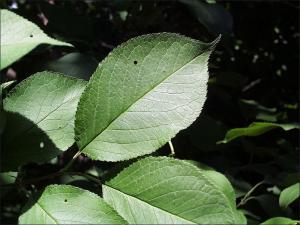 When grown in the open, the common wild plum, (Prunus americana) is a low-branched, rounded tree, but becomes shrubby when grown in thickets or in crowded conditions. It is found throughout the state along fence rows, borders of woods and waste places. It is a valuable wildlife tree.
When grown in the open, the common wild plum, (Prunus americana) is a low-branched, rounded tree, but becomes shrubby when grown in thickets or in crowded conditions. It is found throughout the state along fence rows, borders of woods and waste places. It is a valuable wildlife tree.

Habitat: Grows in open woods, woodland edges, fence rows and along railroad right of ways.
Hardiness: Zones 3 through 10
Growth Rate: Moderate to Fast
Mature Shape: Varies by species
Height: 20-30 feet
Width: 15-25 feet
Site Requirements: Adaptable but prefers moist, well-drained soils. In the right conditions, it will grow like a weed. Withstands heavy pruning and prefers full sun to partial shade.
Leaves: Alternate, simple, single toothed, and oval or oblong shaped.

Flowering Dates: March - May
Seed Dispersal Dates: June - October
Seed Bearing Age: 4 years
Seed Bearing Frequency: Every 1 to 2 years
Seed Stratification: Prechill for 3 to 5 months at 34°F to 40°F
The leaves are similar to cherry leaves in shape, but are thinner, less firm, lighter green and less shiny above; light green beneath and with a wrinkled appearance. The leaves are 3 to 4 inches long with long pointed tips.
The twigs are slender, orange-brown, turning dark reddish brown and marked with tiny raised light dots. The short side twigs are often spiny. The fleshy fruit is sweet, round to oval, about 1 inch in diameter with a rounded seed. It is red to yellowish red when mature in late August. It is used for jams and jellies.
On young stems the bark is orange-brown to dark red-brown and is smooth and shiny. On older stems it is darker colored and breaks into large, thin scales or plates.
Diseases that Can Affect Wild Plum
Insects that Can Affect Wild Plum